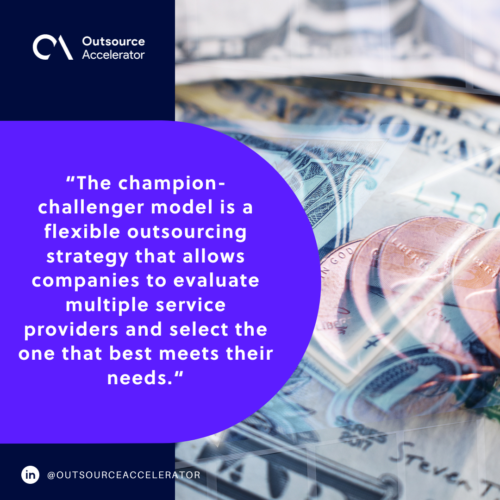This week’s Gone Global is a jam-packed issue full of tech updates and insights on building strong work relationships and how to get richer. Rich is good! Let’s go.
What businesses can learn from the Champion-Challenger model
Businesses, and specifically marketers, are familiar with the concept of A/B testing for outcome improvement. But rarely is this concept ever applied to other parts of an operation.
The outsourcing industry has been using a form of competitive improvement for decades now. It is highly effective and can be used to uncover significant operational gains. It’s called the Champion-Challenger model.
The champion-challenger model is a flexible outsourcing strategy that allows companies to evaluate multiple service providers and select the one that best meets their needs. Typically, you would have the original home-based operations as a control. Then, one or two offshore service providers would be selected to fulfill that same function.
After a period of onboarding and training, you then have three sets of people running the same operation. You have three competing teams, who are all innovating and iterating to become faster, better, and more efficient. Generally, it quickly becomes clear which team is running the best process. But learnings and insights can be gained from all.
It’s like a real-life hackathon on steroids.
One of the biggest advantages of the champion-challenger model is that it allows companies to compare different operators – and approaches – side-by-side, giving them a clear understanding of which solution provider is the best fit for their business.
It also enables companies to be more agile in their outsourcing strategy. In today’s fast-paced business environment, companies need to be able to respond quickly to changes in the market. By outsourcing to a supplier that is flexible and responsive, companies can make adjustments to their customer service strategy as needed without having to go through a long and costly selection process.
Though it’s not without its challenges, for example, the evaluation process can be time-consuming and resource-intensive. Also, the systems might need to be customized to facilitate multiple competing teams.
Importantly, the champion-challenger method can be applied in other areas besides the obvious outsourced functions, such as decision-making, software testing, product development, and more. By testing multiple options and adopting a data-driven approach to make decisions, companies can make better and more informed decisions.
By allowing companies to test multiple options and make informed decisions, the champion-challenger model can help businesses innovate faster, build better systems, stay ahead of the competition and thrive in today’s fast-paced business environment.
The question for your business?
Would competitive testing models improve processes in your business?


 Independent
Independent





















